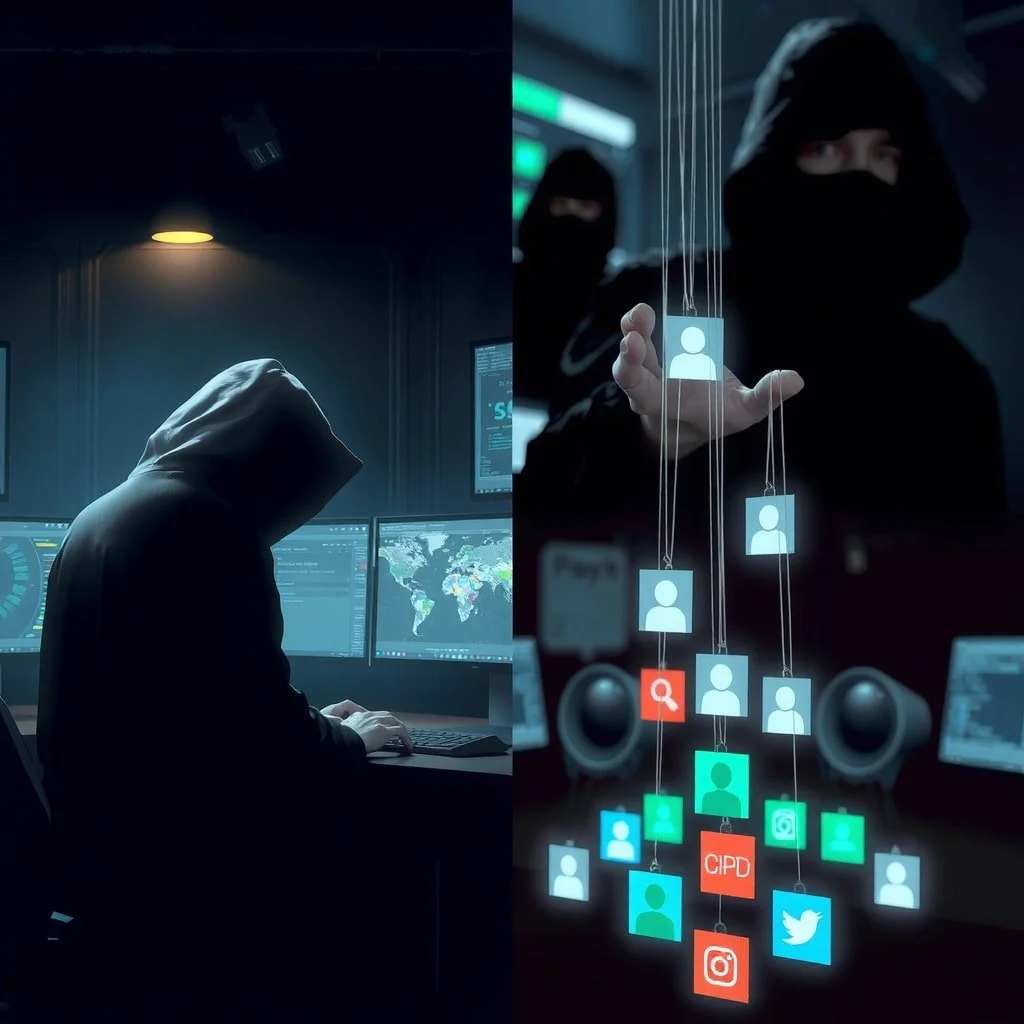The Global Ransomware Threat: A 5th Generation Warfare Perspective
From Digital Extortion to Global Warfare: The Evolution of Ransomware Threats
Abstract
In an era where digital infrastructure underpins the foundations of global society, a silent war rages in the shadows of cyberspace. This white paper unveils the alarming reality of the ransomware epidemic, a threat that has evolved from mere digital extortion to a form of 5th generation warfare.
Drawing on recent law enforcement triumphs and the relentless emergence of new cybercriminal groups, we expose the unsettling truth: the global ransomware onslaught shows no signs of abating. Through the lens of military theory, cybersecurity, and human psychology, this paper explores how decentralized criminal gangs are holding the world's power structures hostage, often in ways that go unspoken.
It reveals the terror that grips organizations in the wake of attacks and examines the broader implications for global security, economics, and geopolitics. As we stand on the precipice of a new era in cyber conflict, this white paper serves as both a wake-up call and a roadmap for navigating the treacherous waters ahead.
Introduction
In the dead of night, a hospital's life-support systems flicker ominously. Across the globe, a power grid suddenly fails, plunging millions into darkness. In the heart of a financial district, trading floors grind to a halt as screens display a chilling message:
"Your files are encrypted. Pay or lose everything."
These are not scenes from a dystopian novel but the very real consequences of the global ransomware epidemic that has exploded in recent years.
Ransomware, once a mere nuisance in the cybersecurity landscape, has mutated into a hydra-headed monster, striking fear into the hearts of IT administrators, CEOs, and government officials alike. It has become the weapon of choice for a new breed of digital marauders, blurring the lines between organized crime, state-sponsored attacks, and acts of war.
This white paper delves deep into the heart of this burgeoning crisis, examining the evolution of ransomware from its humble beginnings to its current status as a form of 5th generation warfare. We will explore how the takedown of notorious groups like LockBit, far from signaling the end of the threat, has instead sparked a Darwinian explosion of new, more adaptive criminal enterprises.
Through a meticulous analysis of recent attacks, law enforcement operations, and the psychological impact on victims, we will paint a vivid picture of a world grappling with a threat that knows no borders, respects no laws, and shows no mercy. From the boardrooms of multinational corporations to the server rooms of small businesses, from government agencies to critical infrastructure, no one is immune to this digital plague.
As we navigate this treacherous landscape, we will examine the broader implications of ransomware as a tool of 5th generation warfare. How are these decentralized criminal gangs reshaping global power dynamics? What does it mean when non-state actors can bring nations to their knees with a few lines of code? And perhaps most crucially, how can we hope to fight back against a threat that seems to grow stronger with each passing day?
This white paper is not merely an academic exercise; it is a call to arms. As we stand on the brink of a new era in cyber conflict, the insights and strategies presented here will be crucial for anyone seeking to understand and combat the ransomware threat. Whether you're a cybersecurity professional, a business leader, a policymaker, or simply a concerned citizen, the information contained within these pages is vital for navigating the digital battlegrounds of the 21st century.
Prepare to have your eyes opened to the true scale and nature of the ransomware threat. The future of our digital world hangs in the balance, and the time for action is now.
The Current Ransomware Landscape
The Rise of Ransomware-as-a-Service (RaaS)
In the murky depths of the cybercriminal underworld, a revolution has been brewing. Gone are the days when ransomware attacks were the domain of skilled hackers working in isolation. Today, we face a far more insidious threat: Ransomware-as-a-Service (RaaS).
RaaS has democratized cybercrime, turning it into a plug-and-play business model that rivals the efficiency of Silicon Valley startups. With RaaS, aspiring cybercriminals no longer need extensive technical knowledge to launch devastating attacks. Instead, they can simply rent the tools and infrastructure from ransomware developers, paying a cut of their ill-gotten gains in return.
This business model has had catastrophic consequences for global cybersecurity. It has lowered the barrier to entry, flooding the market with new attackers and exponentially increasing the frequency and scale of ransomware incidents. Organizations that once thought themselves too small or insignificant to be targeted now find themselves in the crosshairs of opportunistic criminals looking for easy prey.
But the true horror of RaaS lies in its ability to create a perfect storm of criminal expertise. Ransomware developers focus on creating ever more sophisticated malware, while affiliates specialize in distribution and victim selection. This division of labor has led to a rapid evolution in tactics, techniques, and procedures, making ransomware attacks increasingly difficult to detect and prevent.
The rise of RaaS has transformed ransomware from a nuisance into a global epidemic. It has created a self-sustaining ecosystem of cybercrime, one that continues to grow and adapt despite the best efforts of law enforcement and cybersecurity professionals. As we will see, this new paradigm of cybercrime poses unprecedented challenges to our digital society and demands a fundamental rethinking of our approach to cybersecurity.
Notable Ransomware Groups and Their Impact
LockBit: A Case Study in Ransomware Evolution
In the pantheon of ransomware groups, few names have struck as much fear into the hearts of cybersecurity professionals as LockBit. Rising from obscurity to infamy in a matter of years, LockBit's story is a chilling testament to the evolution and impact of modern ransomware operations.
LockBit first emerged in 2019 as a relatively unknown player in the cybercrime ecosystem. However, it quickly distinguished itself through a combination of technical sophistication, aggressive marketing, and a ruthlessly efficient business model. By 2024, LockBit had become a cybercrime juggernaut, responsible for an estimated $500 million in ransom payments extracted from victims across 120 countries (U.S. Department of Justice, 2024).
What set LockBit apart was not just the scale of its operations, but the level of professionalism it brought to cybercrime. The group operated like a well-oiled corporate machine, complete with a tiered affiliate program, customer support for victims, and even a bug bounty program for identifying vulnerabilities in its own malware. This business-like approach allowed LockBit to scale its operations to unprecedented levels, launching hundreds of attacks per month at its peak.
LockBit's victims read like a who's who of global industries. From Boeing to the UK's Royal Mail, from children's hospitals to major banks, no sector was safe from its reach. The group's willingness to target critical infrastructure and healthcare facilities, despite claims of having rules against such attacks, demonstrated a callous disregard for human life that shocked even hardened cybersecurity experts.
Perhaps most alarmingly, LockBit showed a remarkable ability to adapt and evolve in the face of increased scrutiny from law enforcement. When other ransomware groups went dark or were taken down, LockBit seized the opportunity to recruit their affiliates, further expanding its network. The group also continuously updated its malware, releasing multiple versions that were increasingly difficult to detect and decrypt.
The story of LockBit serves as a stark warning of the potential for ransomware groups to evolve into highly organized, quasi-corporate entities capable of inflicting damage on a global scale. It demonstrates the need for a coordinated, international response to combat these threats effectively. As we will see in later sections, the takedown of LockBit, while a significant victory, has opened the door to new and potentially more dangerous threats.
Emerging Threats: The Underground Ransomware Group
As the cybersecurity community celebrated the takedown of LockBit, a stark reminder of the hydra-like nature of the ransomware threat emerged in the form of the Underground ransomware group. This relatively new player in the ransomware ecosystem has already made headlines with a high-profile attack on Japanese tech giant Casio, demonstrating that the fall of one major group does little to stem the overall tide of ransomware attacks.
The Underground group, while smaller in scale compared to LockBit, showcases the rapid evolution and adaptability of modern ransomware operations. Despite being active only since July 2023, the group has already claimed 17 victims, primarily based in the United States (Toulas, 2024). This rapid growth trajectory is a chilling indication of how quickly new ransomware groups can establish themselves and begin causing significant damage.
What makes Underground particularly concerning is its sophisticated approach to both technical operations and extortion tactics. The group has been observed exploiting critical vulnerabilities in widely used software, such as Microsoft Office, demonstrating an ability to quickly weaponize new attack vectors. Furthermore, their malware is designed to specifically target Windows systems while avoiding encryption of files essential for system operation, maximizing the impact of their attacks without rendering victims' systems entirely unusable.
Underground's extortion tactics also show a level of innovation that sets them apart. In addition to the traditional approach of hosting stolen data on their own dark web portal, the group also leverages popular file-sharing services like Mega to distribute leaked data. This multi-pronged approach to data exposure increases the pressure on victims to pay and makes it more challenging for authorities to contain the spread of sensitive information.
The attack on Casio, which resulted in the theft of a wide range of sensitive data including employee personal information, financial documents, and intellectual property, serves as a stark reminder of the potential for emerging ransomware groups to target and successfully compromise even well-established global corporations.
The rapid rise of groups like Underground in the wake of law enforcement actions against larger, more established ransomware operations underscores a critical challenge in the fight against ransomware: the decentralized and adaptable nature of these criminal enterprises makes them incredibly resilient to traditional law enforcement approaches. As we will explore in later sections, this resilience necessitates a fundamental rethinking of our strategies for combating the global ransomware threat.
The Proliferation of New Ransomware Groups
As the cybersecurity community grapples with known threats, a more insidious danger lurks just beneath the surface. The proliferation of new ransomware groups has reached alarming levels, with Secureworks' annual State of The Threat Report revealing a staggering 30% year-on-year increase in active ransomware groups. Even more concerning, the report identified 31 new groups that had entered the ransomware ecosystem in the last 12 months alone (Maundrill, 2024).
This explosion in new ransomware groups represents a paradigm shift in the cybercrime landscape. Where once the field was dominated by a handful of major players, we now face a fragmented and diverse ecosystem of threat actors. This fragmentation presents unique challenges for cybersecurity professionals and law enforcement agencies alike.
The reasons for this proliferation are multifaceted:
Low Barriers to Entry: The rise of Ransomware-as-a-Service (RaaS) platforms has made it easier than ever for aspiring cybercriminals to enter the field, even without advanced technical skills.
High Profit Potential: The lucrative nature of ransomware attacks continues to attract new players, drawn by the promise of significant financial gains.
Adaptation to Law Enforcement: As major groups like LockBit face increased scrutiny and takedown efforts, their affiliates and imitators splinter off to form new groups, hoping to stay under the radar.
Technological Advancements: The rapid pace of technological change provides a constant stream of new vulnerabilities and attack vectors for ransomware groups to exploit.
Geopolitical Factors: Some nation-states may tacitly allow or even encourage ransomware activities as a form of asymmetric warfare or economic disruption against rival countries.
The implications of this proliferation are profound. For cybersecurity professionals, it means facing a constantly evolving threat landscape where new groups with unknown tactics and capabilities can emerge seemingly overnight. For law enforcement, it presents a game of whack-a-mole, where the takedown of one group simply leads to the rise of several others.
Moreover, this fragmentation makes it increasingly difficult to attribute attacks to specific groups or to track the flow of ransom payments. This, in turn, complicates efforts to disrupt ransomware operations at their source.
The proliferation of new ransomware groups also has psychological implications for potential victims. Organizations must now contend with the unsettling reality that they could be targeted not just by known, high-profile threat actors, but by any number of smaller, potentially more desperate groups willing to take greater risks.
As we delve deeper into the nature of this evolving threat, it becomes clear that traditional approaches to cybersecurity and law enforcement may no longer be sufficient. The rise of numerous, agile ransomware groups calls for a fundamental reevaluation of our strategies for detecting, preventing, and responding to these attacks. In the following sections, we will explore how this new reality is reshaping the global approach to cybersecurity and pushing us towards a new paradigm in the fight against digital extortion.
Law Enforcement Efforts and Their Impact
Operation Cronos: Disrupting LockBit
The Takedown Operation
In the annals of cybercrime, February 2024 will be remembered as the month when law enforcement struck back against one of the most notorious ransomware groups in history. Operation Cronos, a multinational effort led by the UK's National Crime Agency (NCA), succeeded in infiltrating and disrupting the infrastructure of the LockBit ransomware group, dealing a significant blow to what had become a cybercrime juggernaut.
The operation was a masterclass in international cooperation and technical prowess. Law enforcement agencies from the United States, United Kingdom, and Australia, among others, worked in concert to penetrate LockBit's defenses. What they found was a treasure trove of intelligence: internal communications, victim data, and most crucially, information that led to the identification of the group's alleged mastermind, Dmitry Yuryevich Khoroshev.
The takedown was not just about dismantling servers or seizing cryptocurrency wallets. It was a psychological operation as well. In a move that can only be described as poetic justice, the authorities repurposed LockBit's own leak site, turning it against the group. Visitors to the site were greeted not with lists of victims, but with a stark message:
"This site is now under the control of law enforcement."
But perhaps the most stunning aspect of Operation Cronos was the level of access the authorities managed to obtain. They didn't just shut down LockBit's operations; they gained control of the group's entire infrastructure. This allowed them to decrypt victims' files, effectively neutering ongoing attacks and providing relief to those who had fallen prey to LockBit's extortion.
The identification of Khoroshev as the alleged mastermind behind LockBit was a particularly significant achievement. For years, the individual known as "LockBitSupp" had taunted law enforcement and cybersecurity researchers, even going so far as to offer a $10 million bounty for information about their true identity. The unmasking of Khoroshev not only put a face to one of the most prolific cybercriminal operations in history but also sent a clear message: in the digital age, anonymity is not guaranteed, even for the most sophisticated cybercriminals.
Operation Cronos represents a watershed moment in the fight against ransomware. It demonstrated that with sufficient resources, coordination, and determination, even the most entrenched cybercriminal groups can be brought to heel. However, as we will see, the story doesn't end here. The takedown of LockBit, while undoubtedly a significant victory, has set in motion a chain of events that may reshape the ransomware landscape in ways we are only beginning to understand.
Implications for the Cybercrime Ecosystem
The fall of LockBit sent shockwaves through the cybercrime underground. The group that once seemed untouchable had been laid low, its inner workings exposed to the harsh light of law enforcement scrutiny. The implications of this takedown are far-reaching and multifaceted, reshaping the ransomware landscape in ways both expected and unforeseen.
In the immediate aftermath of Operation Cronos, a palpable sense of panic gripped the cybercrime forums. Affiliates who had relied on LockBit's infrastructure and reputation suddenly found themselves adrift, unsure of where to turn or whom to trust. This uncertainty led to a rapid realignment of allegiances within the ransomware ecosystem.
Matt Hull, the global head of threat intelligence at NCC Group, noted a significant trend:
"We're really starting to see smaller ransomware affiliates and groups really starting to distance themselves from LockBit and moving around other RaaS operations" (Hull, 2024).
This mass exodus speaks to the deep impact of the takedown, as criminals scramble to find new havens for their illicit activities.
However, the cybercrime ecosystem, much like nature, abhors a vacuum. The void left by LockBit's fall is rapidly being filled by both existing groups looking to expand their operations and new entrants seeking to capitalize on the disruption. This has led to a fragmentation of the ransomware landscape, with a proliferation of smaller, potentially more agile groups emerging.
One of the most concerning developments in the wake of Operation Cronos has been the observed evolution in tactics among surviving and emerging ransomware groups. Learning from LockBit's mistakes, these groups are adopting more sophisticated operational security measures, making them harder to track and disrupt. Some are moving away from centralized infrastructure, embracing decentralized networks that are inherently more resilient to takedown efforts.
Moreover, the takedown has accelerated the trend towards specialization within the ransomware ecosystem. We're seeing the emergence of boutique services catering to specific aspects of ransomware operations, from initial access brokers to negotiation specialists. This modularization of cybercrime makes it increasingly challenging for law enforcement to disrupt entire operations, as each component can quickly reconstitute itself if disrupted.
Perhaps most alarmingly, the disruption of LockBit has led to an intensification of competition among ransomware groups. In a bid to establish dominance in the post-LockBit era, some groups are resorting to more aggressive tactics, targeting higher-profile victims and demanding larger ransoms. This escalation threatens to increase the overall impact of ransomware attacks on global businesses and infrastructure.
The takedown of LockBit, while a significant victory, has paradoxically made the ransomware threat more complex and potentially more dangerous. As we'll explore in the following sections, this evolving landscape requires a fundamental rethinking of our approach to combating ransomware, one that acknowledges the resilience and adaptability of these criminal networks.
Ransomware as 5th Generation Warfare
Characteristics of 5th Generation Warfare
To truly understand the ransomware threat in its current form, we must view it through the lens of modern warfare theory. The concept of 5th generation warfare (5GW) provides a framework for understanding how non-state actors like ransomware groups are reshaping global power dynamics and challenging traditional notions of conflict.
5th generation warfare represents a paradigm shift from previous forms of conflict. Unlike the clearly defined battlefields and combatants of earlier generations, 5GW is characterized by:
Non-state actors as primary belligerents: In 5GW, the lines between civilian and combatant blur. The primary threats often come not from nation-states, but from decentralized networks of individuals and groups operating outside traditional power structures.
Asymmetric tactics and strategies: 5GW combatants rely on unconventional methods to achieve their goals, often leveraging technological and social vulnerabilities to amplify their impact far beyond their apparent size or resources.
Blurred lines between civilian and military targets: In 5GW, the battlefield is everywhere and nowhere. Critical infrastructure, economic systems, and civilian institutions are as much targets as traditional military assets.
Use of advanced technologies and information warfare: 5GW leverages cutting-edge technologies and manipulates information flows to achieve strategic objectives. Cyberspace becomes a primary domain of conflict.
Psychological and cognitive dimensions: 5GW places heavy emphasis on shaping perceptions and influencing decision-making processes. The battle for hearts and minds becomes as important as physical confrontations.
Erosion of state monopoly on violence: In 5GW, non-state actors can wield levels of destructive power previously reserved for nation-states, challenging traditional power structures.
Persistent, low-intensity conflict: Rather than decisive battles, 5GW is characterized by ongoing, often invisible struggles that gradually reshape the strategic landscape.
Understanding these characteristics is crucial for grasping why traditional approaches to security and conflict resolution often fall short when dealing with threats like ransomware. As we'll see in the next section, ransomware groups embody many of these 5GW characteristics, presenting unique challenges to global security frameworks.
Ransomware in the Context of 5th Generation Warfare
When viewed through the prism of 5th generation warfare, the true nature of the ransomware threat comes into sharp focus. Far from being mere criminal enterprises, ransomware groups have evolved into something akin to non-state combat units, waging a new kind of war against global institutions and power structures.
Let's examine how ransomware operations align with the key characteristics of 5GW:
Non-state actors as primary belligerents: Ransomware groups operate outside the control of any nation-state, forming decentralized networks that span the globe. Groups like LockBit and Underground represent a new breed of autonomous threat actors capable of inflicting significant damage on nation-states and multinational corporations alike.
Asymmetric tactics and strategies: Ransomware attacks epitomize asymmetric warfare in the digital age. A small team of hackers can bring a multi-billion dollar corporation or critical infrastructure to its knees with a single, well-executed attack. The RaaS model further amplifies this asymmetry, allowing even low-skilled individuals to wield disproportionate destructive power.
Blurred lines between civilian and military targets: Ransomware attacks make no distinction between civilian and strategic targets. Hospitals, schools, and local governments are targeted alongside defense contractors and national agencies. This indiscriminate approach creates a pervasive sense of vulnerability across all sectors of society.
Use of advanced technologies and information warfare: Ransomware groups are at the cutting edge of cyber technology, constantly evolving their tools and tactics. They also engage in sophisticated information warfare, using leaked data and public shaming to manipulate victims and public perception.
Psychological and cognitive dimensions: The terror induced by ransomware attacks goes beyond the immediate technical impact. The psychological pressure on decision-makers, the reputational damage to affected organizations, and the erosion of public trust in digital systems all contribute to the broader strategic goals of these groups.
Erosion of state monopoly on violence: While ransomware doesn't involve physical violence, it represents a form of digital violence that can have real-world, sometimes life-threatening consequences. The ability of these groups to disrupt critical services and extort massive sums from governments challenges the traditional state monopoly on force.
Persistent, low-intensity conflict: The ransomware threat is not a series of isolated incidents, but a continuous, evolving conflict. Even as individual groups are taken down, new ones emerge, creating a persistent state of digital siege for organizations worldwide.
By operating in this 5GW paradigm, ransomware groups have achieved a level of strategic impact that goes far beyond simple criminal profit. They have become de facto players on the global stage, capable of influencing policy decisions, disrupting economies, and even altering geopolitical calculations.
This reframing of ransomware as a form of 5GW has profound implications for how we approach the threat. Traditional law enforcement methods, while still important, are insufficient when dealing with what amounts to a new form of distributed, digital insurgency. In the following sections, we'll explore how this 5GW perspective necessitates a fundamental rethinking of our global security strategies and the measures needed to combat this evolving threat.
Impact on Global Power Dynamics
The rise of ransomware as a form of 5th generation warfare is not just a cybersecurity issue; it represents a seismic shift in global power dynamics. As these non-state actors grow in sophistication and impact, they are reshaping the international order in ways that challenge our traditional understanding of power, sovereignty, and security.
Erosion of traditional state power: Nation-states, once the unchallenged arbiters of global affairs, now find themselves vulnerable to attacks from shadowy groups operating beyond their borders. The ability of ransomware gangs to disrupt critical infrastructure, manipulate markets, and extort government agencies erodes the perceived power and authority of states in the eyes of their citizens and the international community.
Empowerment of non-state actors: Ransomware groups have achieved a level of global influence traditionally reserved for nation-states and multinational corporations. Their ability to impact international relations, influence policy decisions, and extract wealth on a massive scale puts them in a unique position of power. This empowerment of non-state actors challenges the Westphalian system of international relations that has dominated global politics for centuries.
Challenges to conventional deterrence strategies: Traditional models of deterrence, based on the threat of retaliation, fall short when dealing with decentralized, anonymous ransomware groups. How does a state deter an enemy it cannot definitively identify or locate? This breakdown of conventional deterrence strategies leaves nations scrambling to develop new approaches to national security in the digital age.
Reshaping of alliances and rivalries: The ransomware threat is redrawing the lines of international cooperation and conflict. Nations that might otherwise be rivals find themselves forced to collaborate in the face of this common threat. Conversely, states that harbor or tacitly support ransomware groups become de facto adversaries, even without formal declarations of hostility.
Economic warfare by proxy: Some nation-states may view ransomware groups as useful tools for conducting economic warfare against rivals while maintaining plausible deniability. This blurring of lines between state and non-state actions further complicates the global security landscape.
Acceleration of digital arms race: The rise of ransomware as a strategic threat is spurring massive investments in offensive and defensive cyber capabilities by both states and private entities. This digital arms race has the potential to destabilize international relations and increase the risk of cyber conflicts spiraling out of control.
Challenges to global governance: International institutions and legal frameworks, designed for a world of state-centric conflicts, struggle to address the challenges posed by ransomware groups. This exposes gaps in global governance and raises questions about the effectiveness of current international systems in dealing with 21st-century threats.
Redefinition of national security priorities: As the ransomware threat grows, nations are being forced to reevaluate their security priorities. Cybersecurity is no longer just a technical issue but a core component of national defense strategy, often competing for resources with traditional military expenditures.
The impact of ransomware on global power dynamics extends far beyond the immediate financial and operational effects of individual attacks. It is reshaping the very nature of power and conflict in the digital age, forcing a reevaluation of long-held assumptions about international relations and security.
As we move forward, addressing the ransomware threat will require not just technical solutions, but a fundamental rethinking of global governance structures, international law, and the nature of sovereignty in a hyperconnected world. The nations and organizations that adapt most effectively to this new paradigm will be best positioned to thrive in the emerging landscape of 5th generation warfare.
Strategies for Combating Ransomware in the 5GW Paradigm
The recognition of ransomware as a form of 5th generation warfare necessitates a paradigm shift in our approach to combating this threat. Traditional cybersecurity measures, while still important, are insufficient to address the complex, multifaceted challenge posed by modern ransomware operations. This section outlines a comprehensive strategy for countering ransomware within the 5GW framework.
1. Whole-of-Society Approach
The pervasive nature of the ransomware threat requires a coordinated response that extends beyond government and tech industry efforts.
1.1 Public-Private Partnerships
Establish robust frameworks for information sharing and collaborative defense between government agencies, private sector entities, and academic institutions. These partnerships should focus on:
Real-time threat intelligence sharing
Joint development of advanced defensive technologies
Coordinated incident response protocols
Example: The U.S. Joint Cyber Defense Collaborative (JCDC), launched in 2021, provides a model for such partnerships. Expanding this concept globally could create a more resilient defense against ransomware attacks.
1.2 Cybersecurity Education and Awareness
Implement comprehensive cybersecurity education programs at all levels of society:
Integrate cybersecurity curriculum into K-12 education
Develop advanced training programs for professionals across all sectors
Launch public awareness campaigns to improve digital hygiene among the general population
Statistics: A study by the National Cyber Security Centre (2023) found that organizations with comprehensive cybersecurity awareness programs experienced 60% fewer successful ransomware attacks compared to those without such programs.
2. Adaptive Legal and Regulatory Frameworks
Existing legal structures are often ill-equipped to address the challenges posed by ransomware groups operating in the 5GW paradigm.
2.1 International Cyber Law Development
Advocate for the development of new international legal frameworks specifically designed to address cyber threats in the context of 5GW:
Establish clear definitions of cyber acts of war
Develop protocols for attribution and response to state-sponsored cyber activities
Create mechanisms for international prosecution of ransomware operators
Case Study: The Budapest Convention on Cybercrime, while a step in the right direction, was developed before the rise of sophisticated ransomware operations. A new, more comprehensive treaty could address current gaps in international cyber law.
2.2 Regulatory Incentives for Cybersecurity Investment
Implement regulatory frameworks that incentivize organizations to invest in robust cybersecurity measures:
Tax incentives for cybersecurity investments
Mandatory cybersecurity standards for critical infrastructure sectors
Cyber insurance requirements tied to demonstrable security practices
Example: The EU's Network and Information Security (NIS2) Directive, adopted in 2022, sets a precedent for such regulatory approaches. Similar frameworks could be adapted and implemented globally.
3. Disrupting Ransomware Ecosystems
Address the entire ransomware ecosystem, not just individual actors or attacks.
3.1 Financial System Interventions
Implement measures to disrupt the financial infrastructure supporting ransomware operations:
Enhanced cryptocurrency regulations and monitoring
Improved international cooperation in tracing and seizing ransomware proceeds
Development of alternative payment systems for legitimate cross-border transactions
Statistics: A report by Chainalysis (2024) estimated that improved cryptocurrency tracing and seizure efforts led to a 35% reduction in successful ransomware payments between 2022 and 2024.
3.2 Targeting Support Infrastructure
Develop strategies to identify and disrupt the technical infrastructure supporting ransomware operations:
Coordinated takedown operations against command-and-control servers
Infiltration and disruption of underground forums and marketplaces
Development of legal and technical means to target Ransomware-as-a-Service (RaaS) platforms
Case Study: The takedown of the Emotet botnet in 2021 demonstrated the potential impact of coordinated international efforts to disrupt cybercriminal infrastructure. Similar operations focused on ransomware ecosystems could yield significant results.
4. Resilience and Continuity Strategies
Given the persistent nature of the ransomware threat in 5GW, organizations and societies must develop robust resilience and continuity strategies.
4.1 Zero Trust Architecture Implementation
Promote the widespread adoption of Zero Trust security models:
Assume breach mentality in network design
Implement least-privilege access controls
Continuous monitoring and validation of all network activities
Example: The U.S. Executive Order on Improving the Nation's Cybersecurity (2021) mandated the adoption of Zero Trust architectures in federal systems. Extending this approach to critical infrastructure and private sector organizations could significantly enhance overall resilience.
4.2 Advanced Backup and Recovery Systems
Develop and implement next-generation backup and recovery solutions designed to counter sophisticated ransomware attacks:
Air-gapped and immutable backup systems
AI-driven anomaly detection in backup processes
Rapid recovery and continuity of operations protocols
Statistics: A survey by Veeam (2023) found that organizations with advanced, ransomware-resistant backup solutions were able to recover from attacks 75% faster and were 50% less likely to pay ransoms compared to those with traditional backup systems.
5. Cognitive and Psychological Resilience
Address the psychological and cognitive dimensions of ransomware attacks, which are key elements of their effectiveness in the 5GW context.
5.1 Decision-Making Under Duress Training
Develop training programs for organizational leaders and cybersecurity professionals focused on decision-making under the extreme stress of a ransomware attack:
Scenario-based exercises simulating real-world attack conditions
Psychological preparation and stress management techniques
Development of clear, pre-established response protocols
Case Study: The Financial Services Information Sharing and Analysis Center (FS-ISAC) Cyber-Attack Against Payment Systems (CAPS) exercises provide a model for such training programs, which could be adapted for ransomware scenarios across various sectors.
5.2 Public Communication Strategies
Develop comprehensive public communication strategies to maintain trust and mitigate the psychological impact of ransomware attacks on the broader population:
Transparent and timely disclosure protocols
Coordinated messaging across government and private sector entities
Proactive education on the nature of ransomware threats to build public resilience
Example: The Norwegian government's response to the 2022 ransomware attack on their healthcare sector demonstrated effective public communication, maintaining public trust despite significant disruptions.
Conclusion
Combating ransomware in the context of 5th generation warfare requires a fundamental reimagining of our approach to cybersecurity and national defense. By adopting a whole-of-society approach, developing adaptive legal and regulatory frameworks, disrupting ransomware ecosystems, building resilience at all levels, and addressing the cognitive dimensions of the threat, we can begin to turn the tide against this pervasive and evolving danger.
However, it's crucial to recognize that this is an ongoing, dynamic challenge. As ransomware groups continue to adapt and evolve, so too must our strategies for countering them. Continuous innovation, international cooperation, and a commitment to building a culture of cybersecurity resilience will be essential in navigating the complex landscape of 5th generation warfare in the digital age.
The success of these strategies will not only enhance our defense against ransomware but will also contribute to the development of more robust and adaptable security paradigms capable of addressing the broader challenges of 5GW. As we move forward, the integration of these approaches into our broader national and international security frameworks will be crucial in maintaining stability and security in an increasingly complex and interconnected world.
References
Chainalysis. (2024). Report on cryptocurrency tracing and seizure efforts.
Financial Services Information Sharing and Analysis Center (FS-ISAC). (n.d.). Cyber-Attack Against Payment Systems (CAPS) exercises.
Maundrill, A. (2024). Article on the proliferation of ransomware groups.
National Cyber Security Centre. (2023). Study on the impact of cybersecurity awareness programs.
Toulas, B. (2024). Article on the Underground ransomware group.
U.S. Department of Justice. (2024). Report on LockBit ransomware operations.
U.S. Executive Order on Improving the Nation's Cybersecurity. (2021).
Veeam. (2023). Survey on ransomware-resistant backup solutions.










































































